Jahr
Year
2022

Abstract:
Radio-frequency-driven atmospheric pressure plasma jets (RF APPJs) play an essential role in many technological applications. This work studies the characteristics of these discharges in the so-called non-neutral regime where the conventional structure of a quasi-neutral bulk and an electron depleted sheath does not develop, and the electrons are instead organized in a drift-soliton-like structure that never reaches quasi-neutrality. A hybrid particle-in-cell/Monte Carlo collisions (PIC/MCC) simulation is set up, which combines a fully kinetic electron model via the PIC/MCC algorithm with a drift-diffusion model for the ions. In addition, an analytical model for the electron dynamics is formulated. The formation of the soliton-like structure and the connection between the soliton and the electron dynamics are investigated. The location of the electron group follows a drift equation, while the spatial shape can be described by Poisson–Boltzmann equilibrium in a co-moving frame. A stability analysis is conducted using the Lyapunov method and a linear stability analysis. A comparison of the numerical simulation with the analytical models yields a good agreement.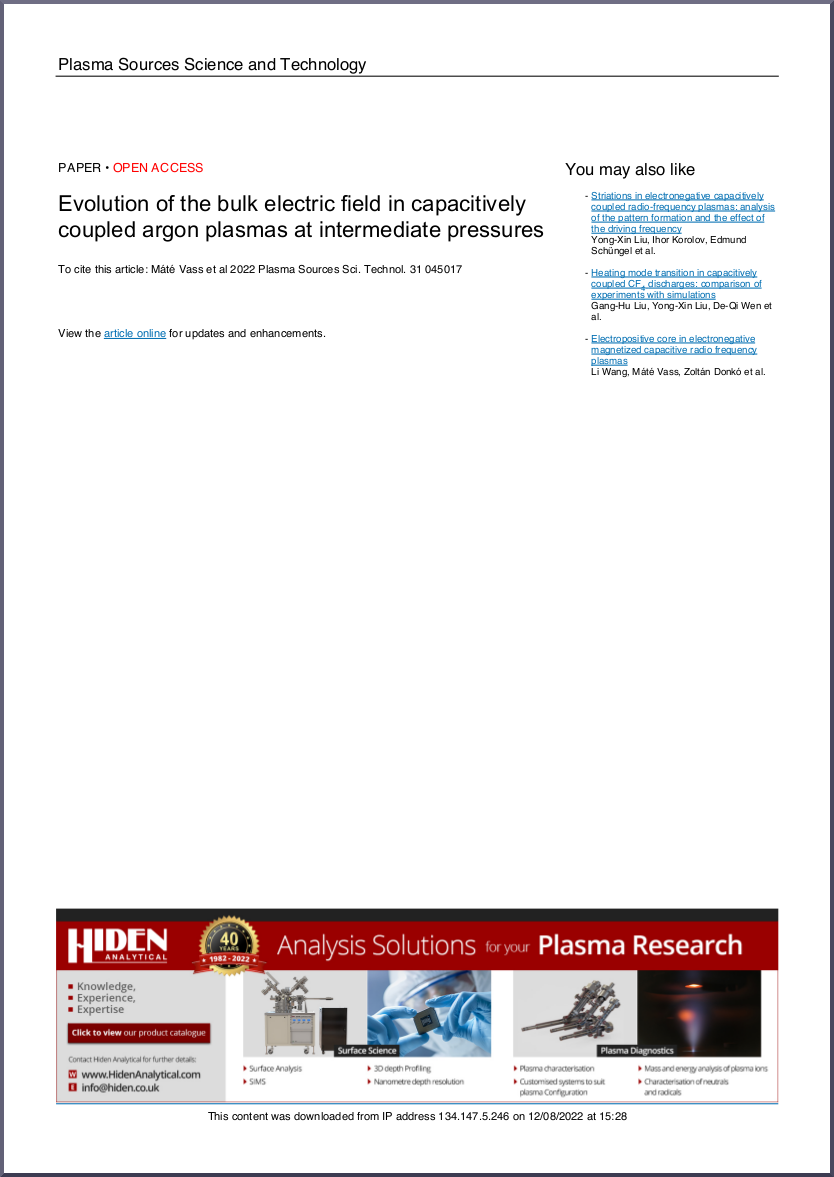
Abstract:
The physical characteristics of an argon discharge excited by a single-frequency harmonic waveform in the low-intermediate pressure regime (5–250 Pa) are investigated using particle-in-cell/Monte Carlo collisions simulations. It is found that, when the pressure is increased, a non-negligible bulk electric field develops due to the presence of a 'passive bulk', where a plateau of constant electron density forms. As the pressure is increased, the ionization in the bulk region decreases (due to the shrinking of the energy relaxation length of electrons accelerated within the sheaths and at the sheath edges), while the excitation rate increases (due to the increase of the bulk electric field). Using the Fourier spectrum of the discharge current, the phase shift between the current and the driving voltage waveform is calculated, which shows that the plasma gets more resistive in this regime. The phase shift and the (wavelength-integrated) intensity of the optical emission from the plasma are also obtained experimentally. The good qualitative agreement of these data with the computed characteristics verifies the simulation model. Using the Boltzmann term analysis method, we find that the bulk electric field is an Ohmic field and that the peculiar shape of the plasma density profile is partially a consequence of the spatio-temporal distribution of the ambipolar electric field.
Abstract:
Bounded plasmas are characterized by a rapid but smooth transition from quasi-neutrality in the volume to electron depletion close to the electrodes and chamber walls. The thin non-neutral region, the boundary sheath, comprises only a small fraction of the discharge domain but controls much of its macroscopic behavior. Insights into the properties of the sheath and its relation to the plasma are of high practical and theoretical interest. The recently proposed smooth step model (SSM) provides a closed analytical expression for the electric field in a planar, radio-frequency modulated sheath. It represents (i) the space charge field in the depletion zone, (ii) the generalized Ohmic and ambipolar field in the quasi-neutral zone, and (iii) a smooth interpolation for the transition in between. This investigation compares the SSM with the predictions of a more fundamental particle-in-cell/Monte Carlo collisions simulation and finds good quantitative agreement when the assumed length and time scale requirements are met. A second simulation case illustrates that the model remains applicable even when the assumptions are only marginally fulfilled.2021
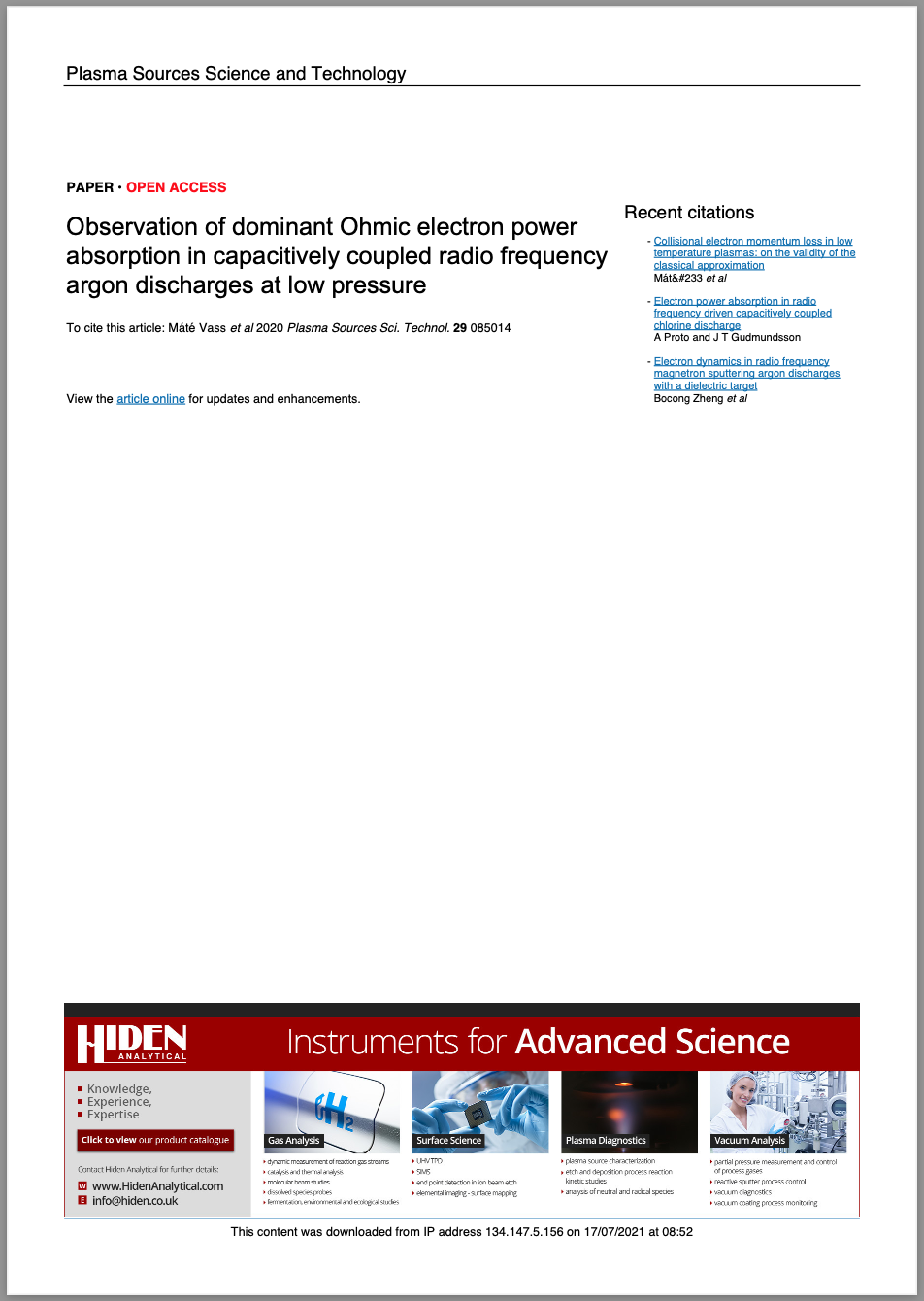
Abstract:
In atmospheric pressure capacitively-coupled microplasma jets, voltage waveform tailoring (VWT) was demonstrated to provide ultimate control of the electron energy distribution function (EEDF), which allows us to enhance and adjust the generation of selected neutral species by controlling the electron power absorption dynamics. However, at the fundamental level, the physical origin of these effects of VWT remained unclear. Therefore, in this work, the electron power absorption dynamics is investigated in a He/N2 jet with a nitrogen concentration of 0.05% driven by a valleys voltage waveform at a base frequency of 13.56 MHz for different numbers of harmonics, using a self-consistent particle-in-cell simulation coupled with a spatio-temporally resolved analysis of the electron power absorption based on moments of the Boltzmann equation. Due to the local nature of the transport at atmospheric pressure, ohmic power absorption is dominant. Increasing the number of harmonics, due to the peculiar shape of the excitation waveform, the sheath collapse at the grounded electrode is shortened relative to the one at the powered electrode. As a consequence, and in order to ensure flux compensation of electrons and positive ions at this electrode, a high current is driven through the discharge at the time of this short sheath collapse. This current is primarily driven by a high ohmic electric field. Close to the grounded electrode, where the electron density is low and the electric field is therefore high, electrons are accelerated to high energies and strong ionization, as well as the formation of a local electron density maximum, are observed. This electron density maximum leads to a local ambipolar electric field that acts as an electric field reversal and accelerates electrons to even higher energies. These effects are understood in detail to fundamentally explain the unique potential of VWT for EEDF control in such plasmas.
Abstract:
Particle based simulations are indispensable tools for numerical studies of charged particle swarms and low-temperature plasma sources. The main advantage of such approaches is that they do not require any assumptions regarding the shape of the particle velocity/energy distribution function (VDF/EDF), but provide these basic quantities of kinetic theory as a result of the computations. Additionally, they can provide, e.g. transport coefficients, under arbitrary time and space dependence of the electric/magnetic fields. For the self-consistent description of various plasma sources operated in the low-pressure (nonlocal, kinetic) regime, the particle-in-cell simulation approach, combined with the Monte Carlo treatment of collision processes (PIC/MCC), has become an important tool during the past decades. In particular, for radio-frequency (RF) capacitively coupled plasma (CCP) systems PIC/MCC is perhaps the primary simulation tool these days. This approach is able to describe discharges over a wide range of operating conditions, and has largely contributed to the understanding of the physics of CCPs operating in various gases and their mixtures, in chambers with simple and complicated geometries, driven by single- and multi-frequency (tailored) waveforms. PIC/MCC simulation codes have been developed and maintained by many research groups, some of these codes are available to the community as freeware resources. While this computational approach has already been present for a number of decades, the rapid evolution of the computing infrastructure makes it increasingly more popular and accessible, as simulations of simple systems can be executed now on personal computers or laptops. During the past few years we have experienced an increasing interest in lectures and courses dealing with the basics of particle simulations, including the PIC/MCC technique. In a response to this, the current paper (i) provides a tutorial on the physical basis and the algorithms of the PIC/MCC technique and (ii) presents a basic (spatially one-dimensional) electrostatic PIC/MCC simulation code, whose source is made freely available in various programming languages. We share the code in C/C++ versions, as well as in a version written in Rust, which is a rapidly emerging computational language. Our code intends to be a 'starting tool' for those who are interested in learning the details of the PIC/MCC technique and would like to develop the 'skeleton' code further, for their research purposes. Following the description of the physical basis and the algorithms used in the code, a few examples of results obtained with this code for single- and dual-frequency CCPs in argon are also given.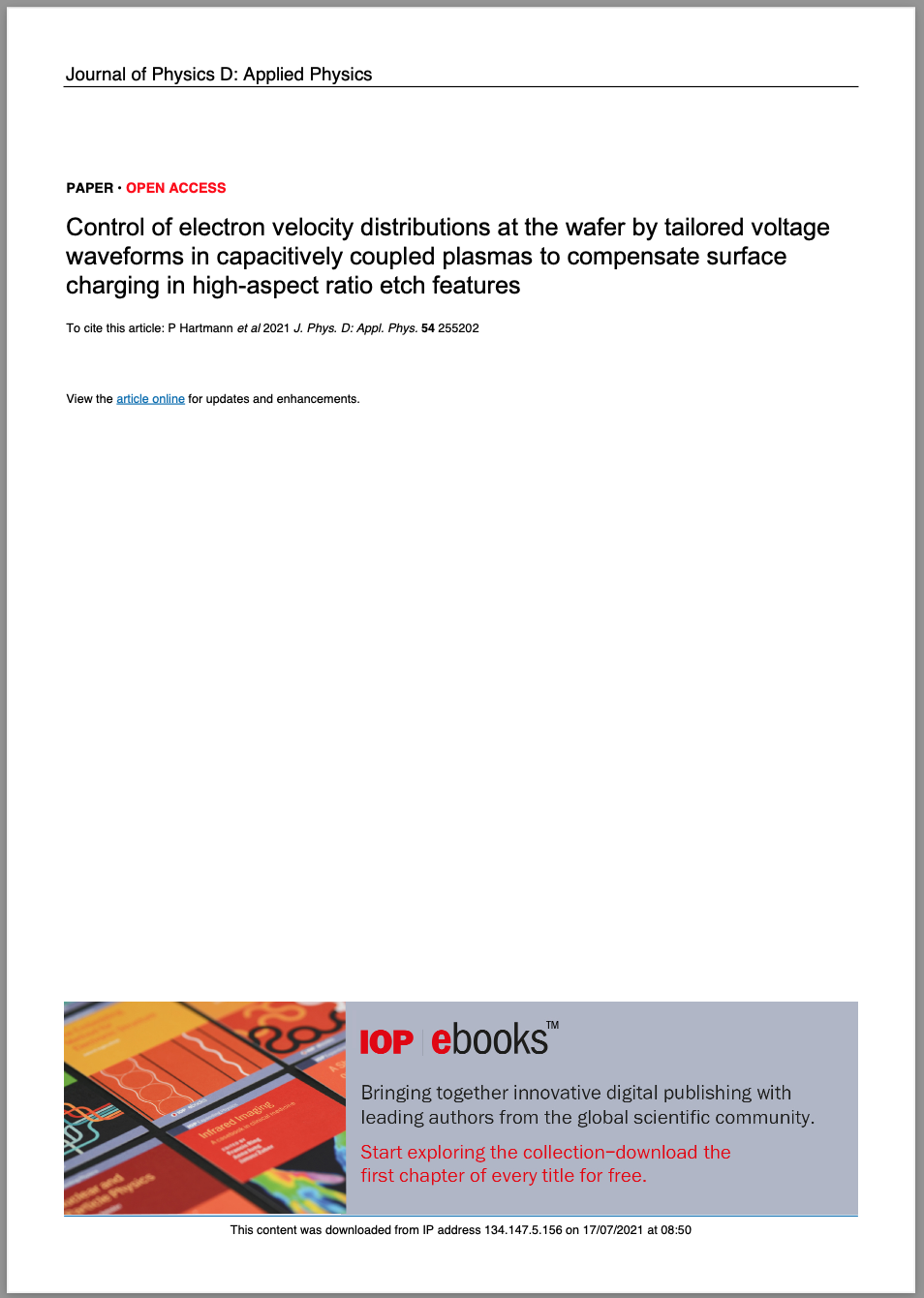
Abstract:
Low pressure single- or dual-frequency capacitively coupled radio frequency (RF) plasmas are frequently used for high-aspect ratio (HAR) dielectric etching due to their capability to generate vertical ion bombardment of the wafer at high energies. Electrons typically reach the wafer at low energies and with a wide angular distribution during the local sheath collapse. Thus, in contrast to positive ions, electrons cannot propagate deeply into HAR etch features and the bottom as well as the sidewalls of such trenches can charge up positively, while the mask charges negatively. This causes etch stops and distortion of profile shapes. Here, we investigate low pressure, high voltage capacitively coupled RF argon gas discharges by Particle-In-Cell/Monte Carlo collisions simulations and demonstrate that this problem can be solved by Voltage Waveform Tailoring, i.e. the velocity and angular distribution of electrons impacting on the electrodes can be tuned towards high velocities and small angles to the surface-normal, while keeping the energies of the impacting ions high. The applied voltage waveforms consist of a base frequency of 400 kHz with 10 kV amplitude and a series of higher harmonics. A high frequency component at 40 or 60 MHz is used additionally. Square voltage waveforms with different rise-times are examined as well. We show that high fluxes of electrons towards the wafer at normal velocities of up to 2.2 × 10^7 m/s (corresponding to 1.4 keV energy) can be realized.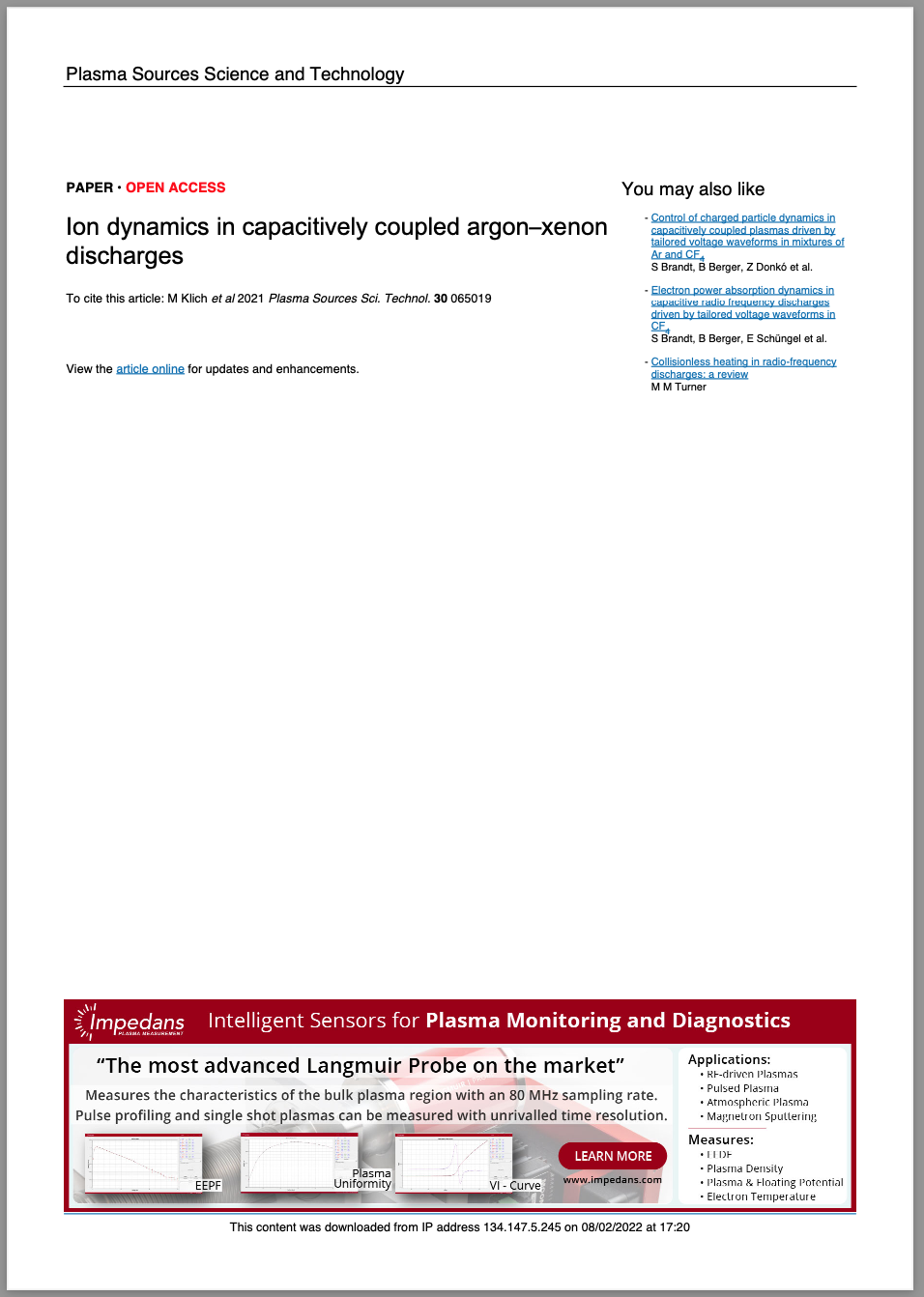
Abstract:
An argon–xenon (Ar/Xe) plasma is used as a model system for complex plasmas. Based on this system, symmetric low-pressure capacitively coupled radiofrequency discharges are examined utilizing particle-in-cell/Monte Carlo collisions simulations. In addition to the simulation, an analytical energy balance model fed with the simulation data is applied to analyze the findings further. This work focuses on investigating the ion dynamics in a plasma with two ion species and a gas mixture as background. By varying the gas composition and driving voltage of the single-frequency discharge, fundamental mechanics of the discharge, such as the evolution of the plasma density and the energy dispersion, are discussed. Thereby, close attention is paid to these measures' influence on the ion energy distribution functions at the electrode surfaces. The results show that both the gas composition and the driving voltage can significantly impact the ion dynamics. The mixing ratio of argon to xenon allows for shifting the distribution function for one ion species from collisionless to collision dominated. The mixing ratio serves as a control parameter for the ion flux and the impingement energy of ions at the surfaces. Additionally, a synergy effect between the ionization of argon and the ionization of xenon is found and discussed.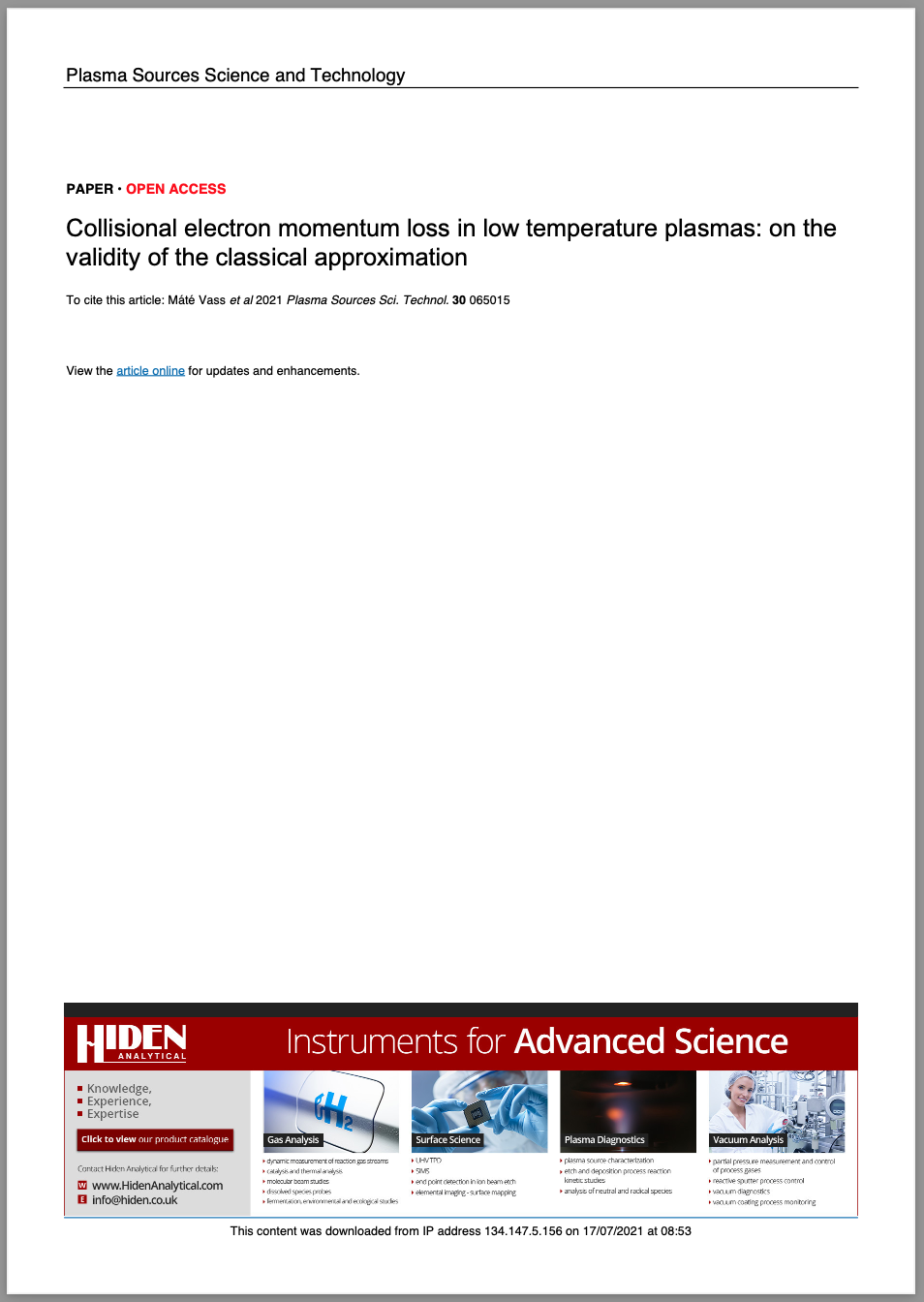
Abstract:
The electron momentum loss obtained from kinetic simulations, as well as the classical approximation based on the electron–neutral collision frequency, are calculated and compared in low pressure capacitively coupled plasmas in argon, helium and oxygen gases. The classical approximation (which is commonly used in theoretical or numerical fluid models) exaggerates the role of low-energy electrons and can lead to a significantly lower momentum loss compared to the exact momentum loss depending on the gas used, even if the exact electron distribution function is known. This leads to an underestimation of the Ohmic power absorption and a change in the harmonic content of the momentum loss as revealed by Fourier analysis. For argon, the classical approximation is found to be particularly poor and is partially related to the presence of a Ramsauer–Townsend minimum in the momentum transfer cross-section at low electron energies: a fact confirmed by using a 'fake' argon gas where the Ramsauer–Townsend minimum is artificially removed. The results are of broad general relevance to low-temperature plasmas, and can be useful for assessing errors in plasma fluid models.2020
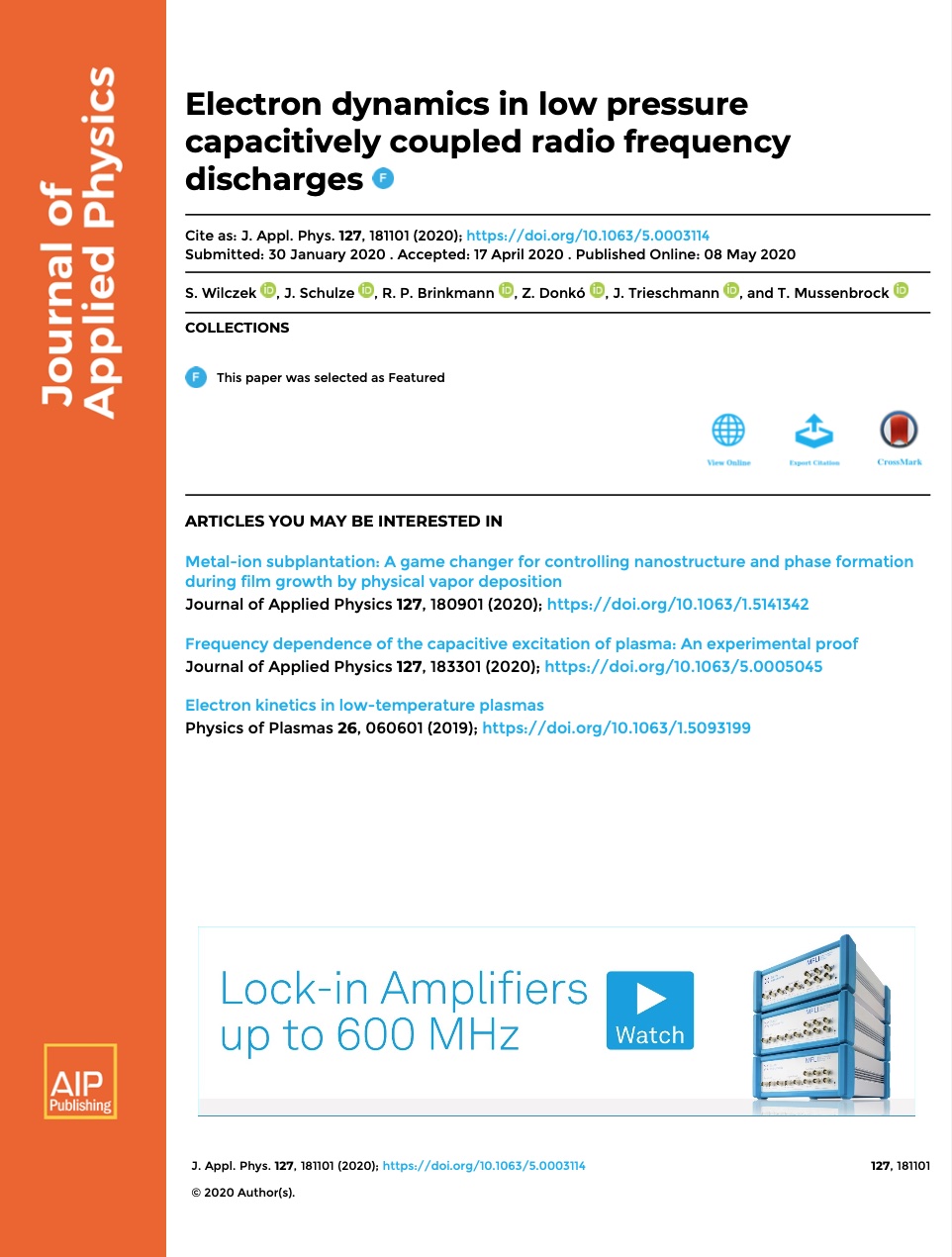
Abstract:
In low temperature plasmas, the interaction of the electrons with the electric field is an important current research topic that is relevant for many applications. Particularly, in the low pressure regime (≤10 Pa), electrons can traverse a distance that may be comparable to the reactor dimensions without any collisions. This causes “nonlocal,” dynamics which results in a complicated space- and time-dependence and a strong anisotropy of the distribution function. Capacitively coupled radio frequency (CCRF) discharges, which operate in this regime, exhibit extremely complex electron dynamics. This is because the electrons interact with the space- and time-dependent electric field, which arises in the plasma boundary sheaths and oscillates at the applied radio frequency. In this tutorial paper, the fundamental physics of electron dynamics in a low pressure electropositive argon discharge is investigated by means of particle-in-cell/Monte Carlo collisions simulations. The interplay between the fundamental plasma parameters (densities, fields, currents, and temperatures) is explained by analysis (aided by animations) with respect to the spatial and temporal dynamics. Finally, the rendered picture provides an overview of how electrons gain and lose their energy in CCRF discharges.
Abstract:
We present a spatio-temporally resolved analysis of electron power absorption in capacitively coupled argon plasmas at low pressures (1–10 Pa), based on the 1D momentum balance equation embedded into 1d3v particle-in-cell/Monte Carlo collisions simulations. In contrast to the predictions of theoretical models we find 'Ohmic heating' to be the dominant electron power absorption mechanism on time average at the lowest pressures, and not 'stochastic' or 'Pressure heating'. The cause for this is identified to be the attenuation of electron power absorption due to electron acceleration by the 'ambipolar' electric field on time average at low pressure, which is a consequence of the collisionless transit of energetic beam electrons generated during sheath expansion at one electrode to the opposite electrode. At such conditions, these energetic electrons arrive during the local sheath collapse and can be lost to the surface, thereby reducing the plasma density and creating a temporally more symmetric electron temperature within the radio frequency (RF) period compared to that in discharges operated at higher pressures. The more symmetric temperature profile causes a reduction of 'Pressure heating' on time average. The latter is reduced further, even to negative values, by the attenuation of the 'ambipolar' electric field at each electrode during the local sheath collapse, which is a consequence of the temporal modulation of the electron density profile within the RF period, observed at the lowest pressures studied.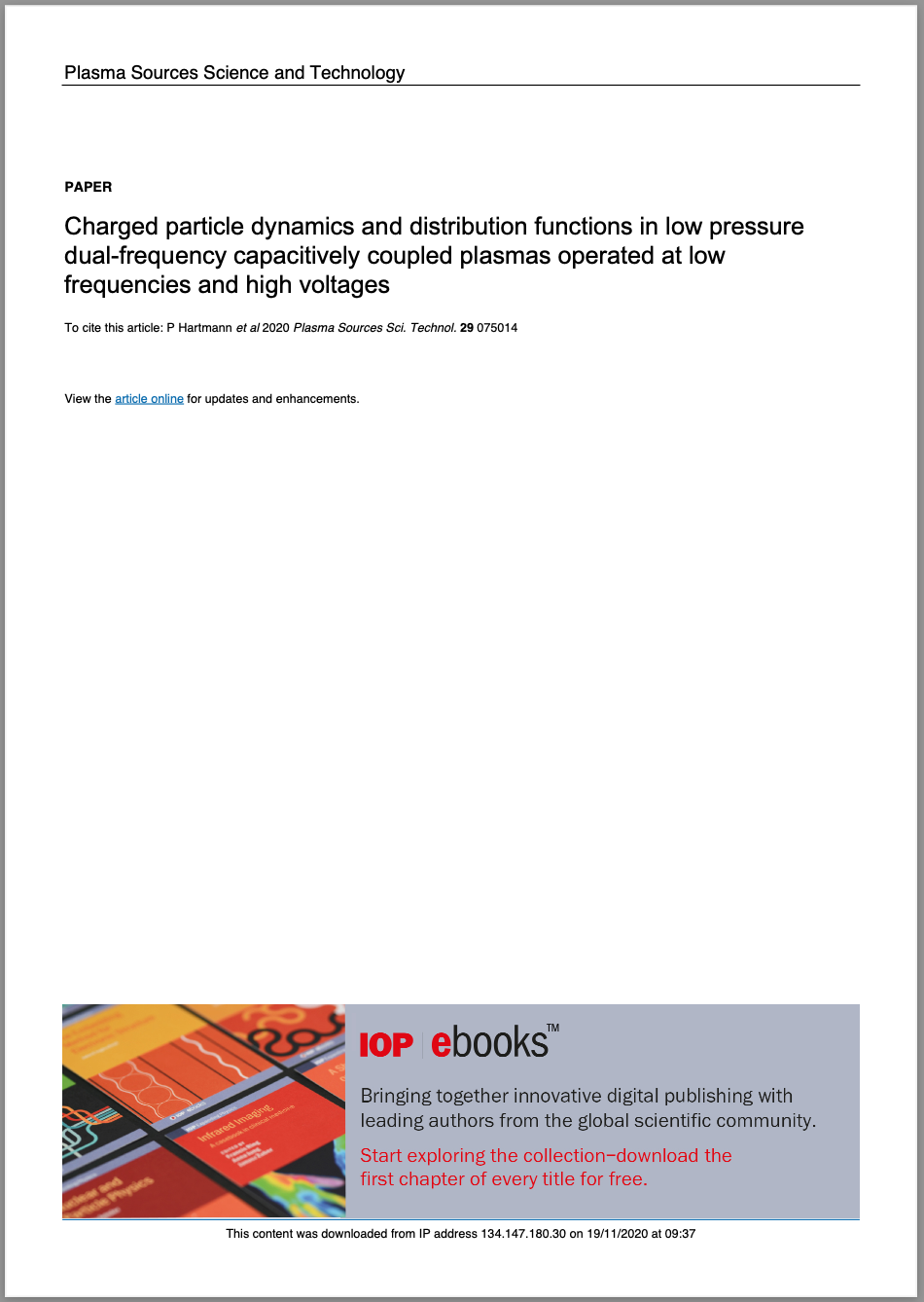
Abstract:
In high aspect ratio (HAR) dielectric plasma etching, dual-frequency capacitively coupled radio-frequency plasmas operated at low pressures of 1 Pa or less are used. Such plasma sources are often driven by a voltage waveform that includes a low-frequency component in the range of hundreds of kHz with a voltage amplitude of 10 kV and more to generate highly energetic vertical ion bombardment at the wafer. In such discharges, the energetic positive ions can overcome the repelling potential created by positive wall charges inside the etch features, which allows high aspect ratios to be reached. In order to increase the plasma density a high-frequency driving component at several 10 MHz is typically applied simultaneously. Under such discharge conditions, the boundary surfaces are bombarded by extremely energetic particles, of which the consequences are poorly understood. We investigate the charged particle dynamics and distribution functions in this strongly non-local regime in argon discharges by particle-in-cell simulations. By including a complex implementation of plasma-surface interactions, electron induced secondary electron emission (δ-electrons) is found to have a strong effect on the ionization dynamics and the plasma density. Due to the high ion energies at the electrodes, very high yields of the ion induced secondary electron emission (γ-electrons) are found. However, unlike in classical capacitive plasmas, these γ-electrons do not cause significant ionization directly, since upon acceleration in the high voltage sheaths, these electrons are too energetic to ionize the neutral gas efficiently. These γ- and δ-electrons as well as electrons created in the plasma bulk and accelerated towards the electrodes to high energies by reversed electric fields during the local sheath collapse are found to induce the emission of a high number of δ-electrons, when they hit boundary surfaces. This regime is understood fundamentally based on the following approach: first, dual-frequency discharges with identical electrode materials are studied at different pressures and high-frequency driving voltages. Second, the effects of using electrodes made of different materials and characterized by different secondary electron emission coefficients are studied. The electron dynamics and charged particle distribution functions at boundary surfaces are determined including discharge asymmetries generated by using different materials at the powered and grounded electrodes.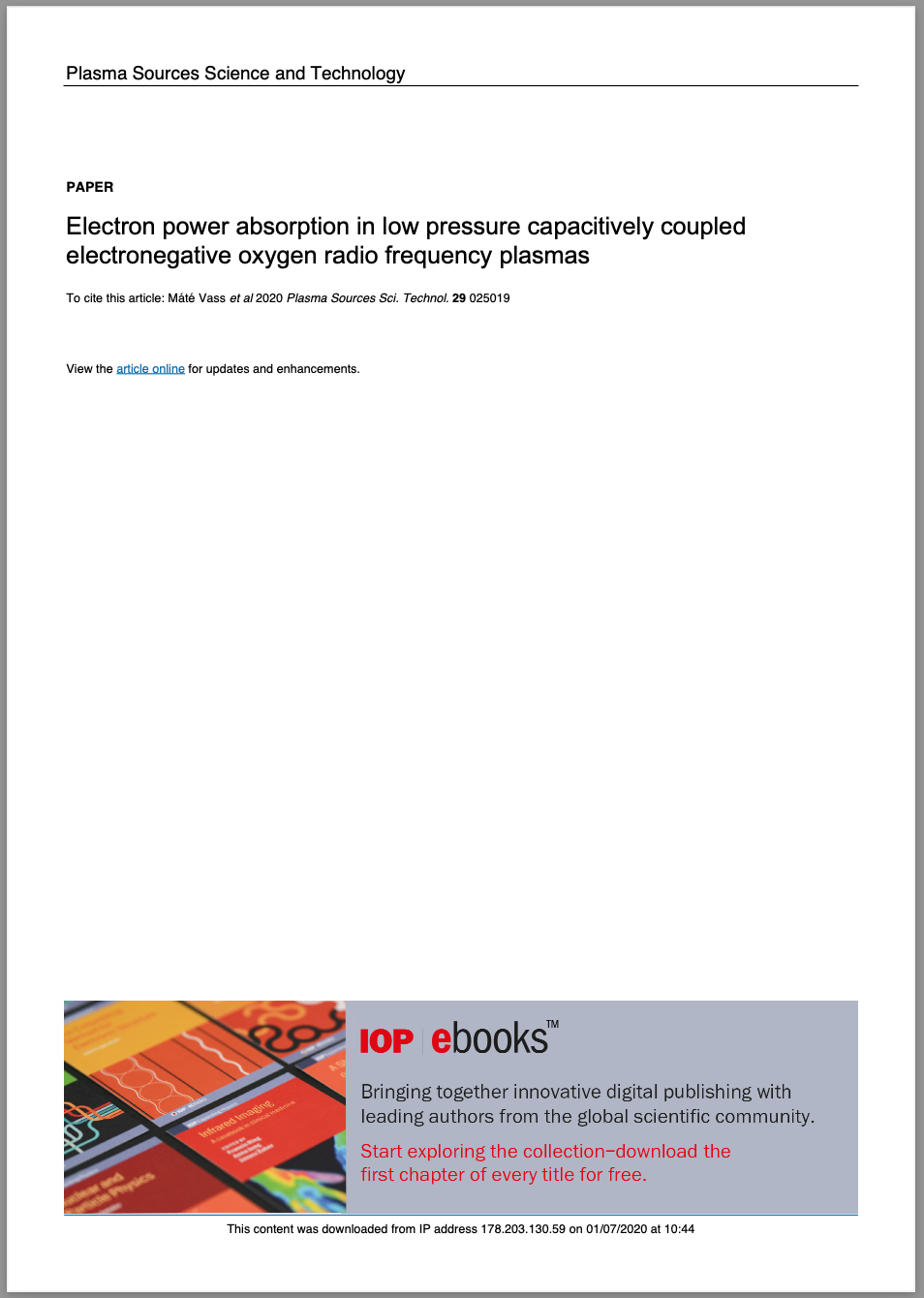
Abstract:
A thorough understanding of the energy transfer mechanism from the electric field to electrons is of utmost importance for optimisation and control of different plasma sources and processes. This mechanism, called electron power absorption, involves complex electron dynamics in electronegative capacitively coupled plasmas (CCPs) at low pressures, that are still not fully understood. Therefore, we present a spatio-temporally resolved analysis of electron power absorption in low pressure oxygen CCPs based on the momentum balance equation derived from the Boltzmann equation. Data are obtained from 1d3v particle-in-cell/Monte Carlo Collision simulations. In contrast to conventional theoretical models, which predict 'stochastic/collisionless heating' to be important at low pressure, we observe the dominance of Ohmic power absorption. In addition, there is an attenuation of ambipolar power absorption at low pressures due to the strong electronegativity, and the presence of electropositive edge regions in the discharge, which cause a high degree of temporal symmetry of the electron temperature within the RF period.2019

Abstract:
A thorough understanding of the energy transfer mechanism from the electric field to electrons is of utmost importance for optimisation and control of different plasma sources and processes. This mechanism, called electron power absorption, involves complex electron dynamics in electronegative capacitively coupled plasmas (CCPs) at low pressures, that are still not fully understood. Therefore, we present a spatio-temporally resolved analysis of electron power absorption in low pressure oxygen CCPs based on the momentum balance equation derived from the Boltzmann equation. Data are obtained from 1d3v particle-in-cell/Monte Carlo Collision simulations. In contrast to conventional theoretical models, which predict 'stochastic/collisionless heating' to be important at low pressure, we observe the dominance of Ohmic power absorption. In addition, there is an attenuation of ambipolar power absorption at low pressures due to the strong electronegativity, and the presence of electropositive edge regions in the discharge, which cause a high degree of temporal symmetry of the electron temperature within the RF period.2018
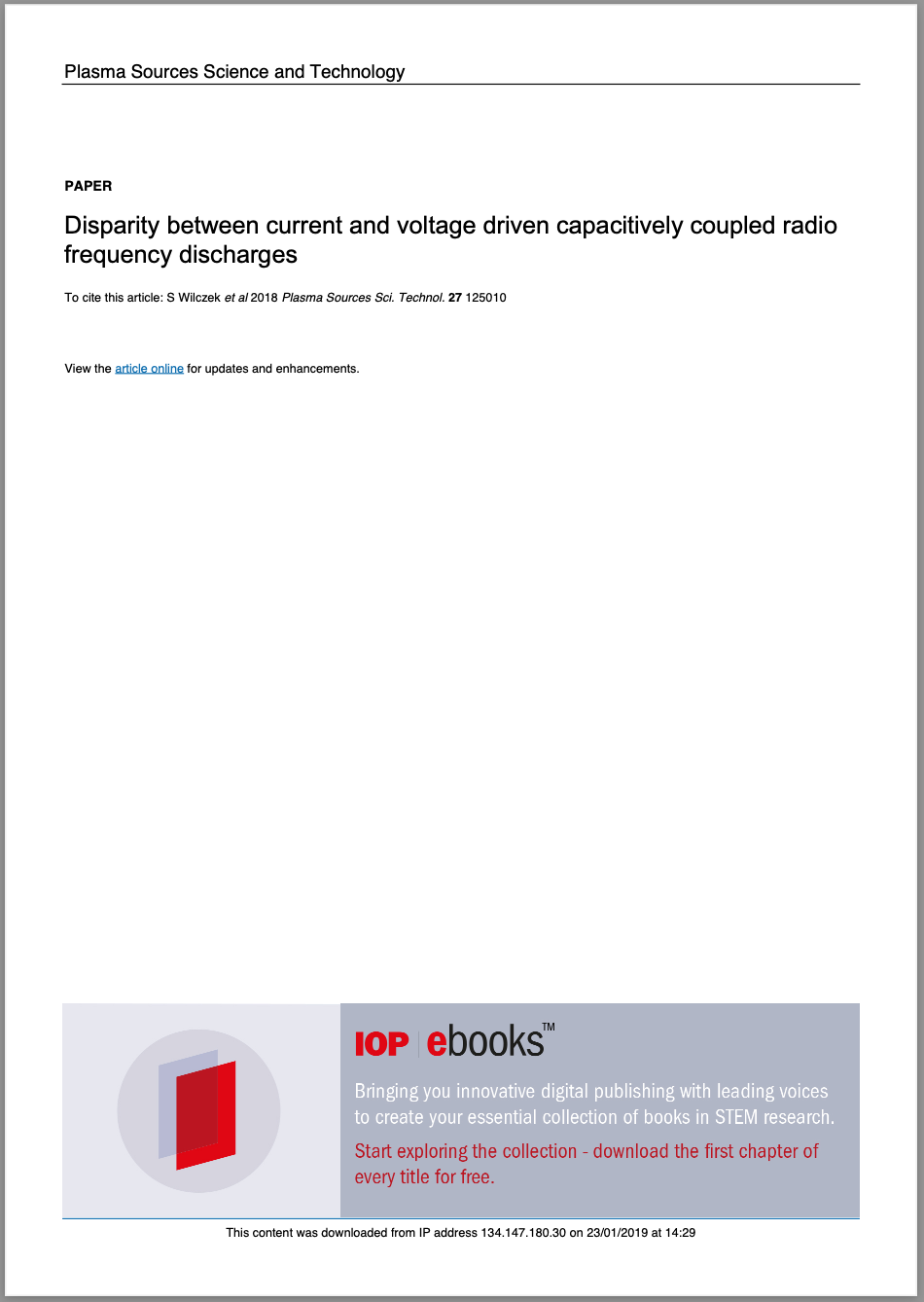
Abstract:
In simulation as well as analytical modeling studies of low-pressure capacitively coupled radio frequency (CCRF) discharges, the assumption of both a driving voltage source or a driving current source is commonly used. It is unclear, however, how and to what extent the choice of the mode of driving, that prescribes either a sinusoidal discharge voltage or a sinusoidal discharge current, itself defines the discharge dynamics that results from these studies. To address this issue, 1d3v cylindrical particle-in-cell/Monte Carlo collisions simulations of asymmetric CCRF discharges are performed in the low pressure regime. We study the nonlocal and nonlinear dynamics of these discharges on a nanosecond timescale. We find that the excitation of the plasma series resonance in the voltage driven case strongly enhances the nonlinear electron power dissipation. However, this resonance is suppressed when a current source is used, because the excitation of harmonics in the RF current is not allowed. Consequently, significant differences between both driving sources are observed in the plasma density as well as in the electron and the power coupling dynamics. We conclude that caution is advised in comparisons between simulations and experiments, as in the former the discharge dynamics is partly defined by the method of driving of the plasma source, while in the latter the addressed resonance phenomena are inherently present at low pressures, since experiments are typically voltage driven.
Abstract:
Power absorption by electrons from the space- and time-dependent electric field represents the basic sustaining mechanism of all radio-frequency driven plasmas. This complex phenomenon has attracted significant attention. However, most theories and models are, so far, only able to account for part of the relevant mechanisms. The aim of this work is to present an in-depth analysis of the power absorption by electrons, via the use of a moment analysis of the Boltzmann equation without any ad-hoc assumptions. This analysis, for which the input quantities are taken from kinetic, particle based simulations, allows the identification of all physical mechanisms involved and an accurate quantification of their contributions. The perfect agreement between the sum of these contributions and the simulation results verifies the completeness of the model. We study the relative importance of these mechanisms as a function of pressure, with high spatial and temporal resolution, in an electropositive argon discharge. In contrast to some widely accepted previous models we find that high space- and time-dependent ambipolar electric fields outside the sheaths play a key role for electron power absorption. This ambipolar field is time-dependent within the RF period and temporally asymmetric, i.e., the sheath expansion is not a 'mirror image' of the sheath collapse. We demonstrate that this time-dependence is mainly caused by a time modulation of the electron temperature resulting from the energy transfer to electrons by the ambipolar field itself during sheath expansion. We provide a theoretical proof that this ambipolar electron power absorption would vanish completely, if the electron temperature was constant in time. This mechanism of electron power absorption is based on a time modulated electron temperature, markedly different from the Hard Wall Model, of key importance for energy transfer to electrons on time average and, thus, essential for the generation of capacitively coupled plasmas.2017
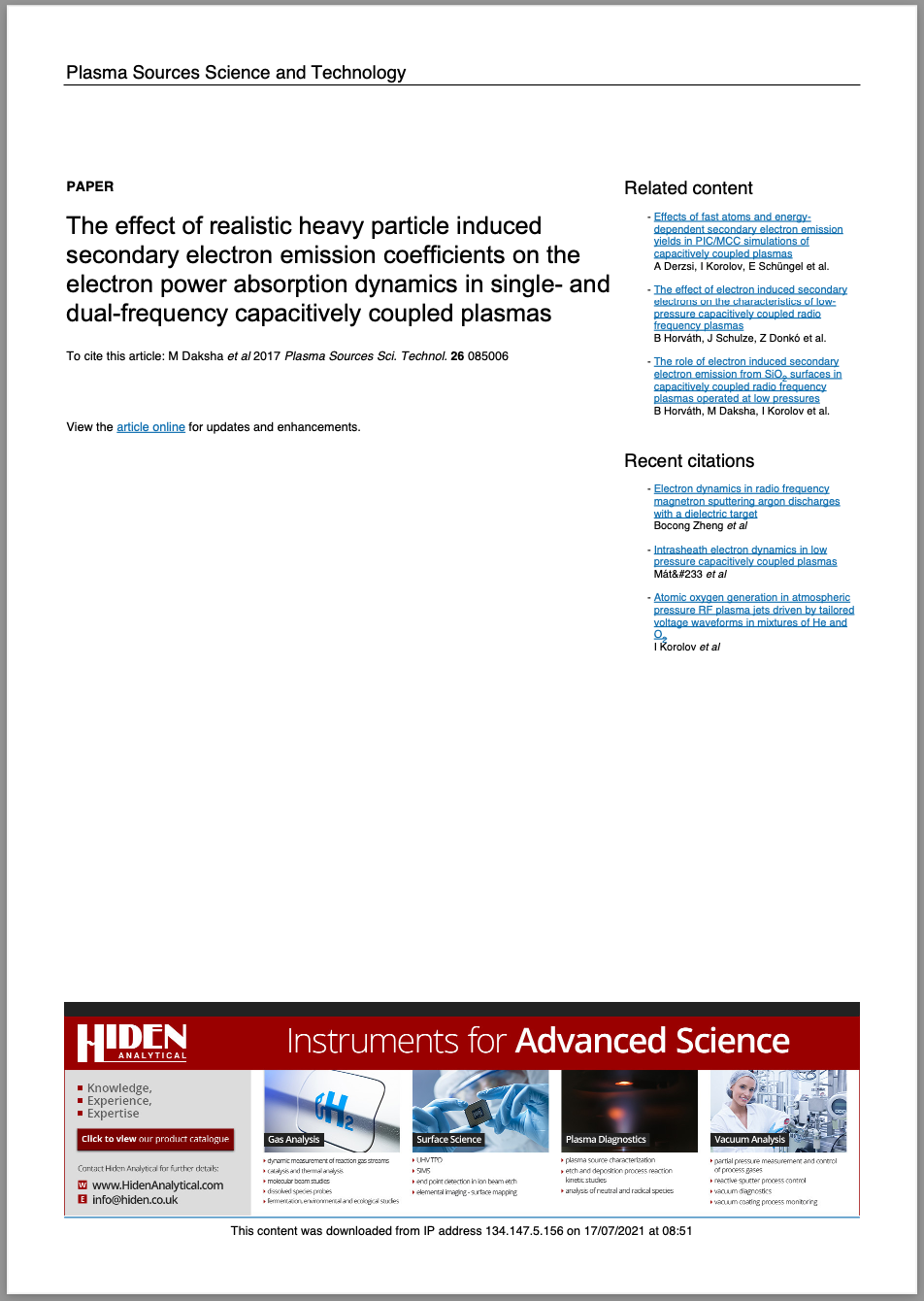
Abstract:
In particle-in-cell/Monte Carlo collisions (PIC/MCC) simulations of capacitively coupled plasmas (CCPs), the plasma-surface interaction is generally described by a simple model in which a constant secondary electron emission coefficient (SEEC) is assumed for ions bombarding the electrodes. In most PIC/MCC studies of CCPs, this coefficient is set to γ = 0.1, independent of the energy of the incident particle, the electrode material, and the surface conditions. Here, the effects of implementing energy-dependent secondary electron yields for ions, fast neutrals, and taking surface conditions into account in PIC/MCC simulations is investigated. Simulations are performed using self-consistently calculated effective SEECs, γ, for 'clean' (e.g., heavily sputtered) and 'dirty' (e.g., oxidized) metal surfaces in single- and dual-frequency discharges in argon and the results are compared to those obtained by assuming a constant secondary electron yield of γ =0.1 for ions. In single-frequency (13.56 MHz) discharges operated under conditions of low heavy particle energies at the electrodes, the pressure and voltage at which the transition between the α- and γ-mode electron power absorption occurs are found to strongly depend on the surface conditions. For 'dirty' surfaces, the discharge operates in α-mode for all conditions investigated due to a low effective SEEC. In classical dual-frequency (1.937 MHz + 27.12 MHz) discharges γ significantly increases with increasing low-frequency voltage amplitude, V_lf, for dirty surfaces. This is due to the effect of V_lf on the heavy particle energies at the electrodes, which negatively influences the quality of the separate control of ion properties at the electrodes. The new results on the separate control of ion properties in such discharges indicate significant differences compared to previous results obtained with different constant values of γ.2016
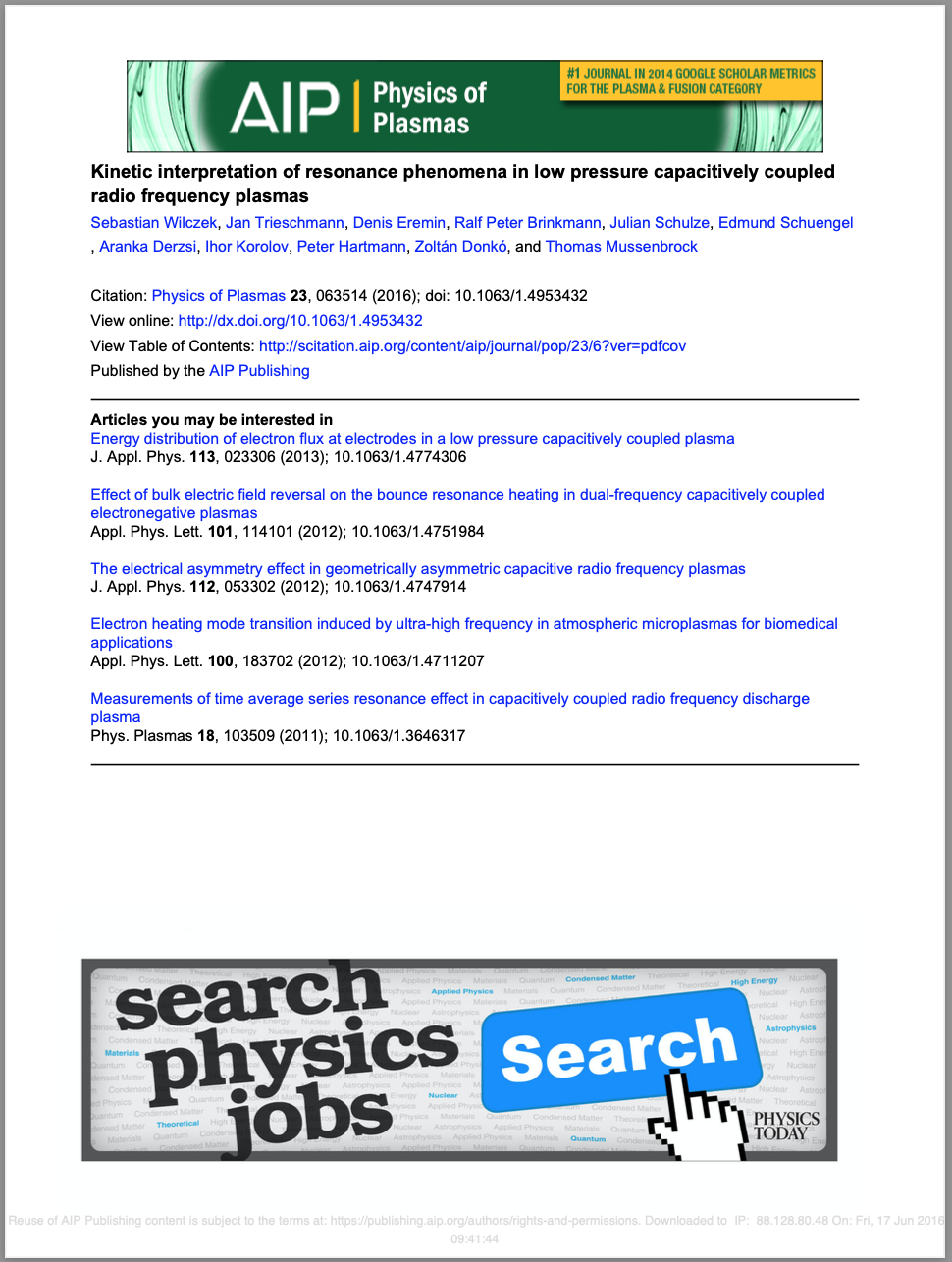
Abstract:
Low pressure capacitive radio frequency (RF) plasmas are often described by equivalent circuit models based on fluid approaches that predict the self-excitation of resonances, e.g., high frequency oscillations of the total current in asymmetric discharges, but do not provide a kinetic interpretation of these effects. In fact, they leave important questions open: How is current continuity ensured in the presence of energetic electron beams generated by the expanding sheaths that lead to a local enhancement of the conduction current propagating through the bulk? How do the beam electrons interact with cold bulk electrons? What is the kinetic origin of resonance phenomena? Based on kinetic simulations, we find that the energetic beam electrons interact with cold bulk electrons (modulated on a timescale of the inverse local electron plasma frequency) via a time dependent electric field outside the sheaths. This electric field is caused by the electron beam itself, which leaves behind a positive space charge, that attracts cold bulk electrons towards the expanding sheath. The resulting displacement current ensures current continuity by locally compensating the enhancement of the conduction current. The backflow of cold electrons and their interaction with the nonlinear plasma sheath cause the generation of multiple electron beams during one phase of sheath expansion and contribute to a strongly non-sinusoidal RF current. These kinetic mechanisms are the basis for a fundamental understanding of the electron power absorption dynamics and resonance phenomena in such plasmas, which are found to occur in discharges of different symmetries including perfectly symmetric plasmas.2015
